IHRM Analysis: Nestle's International Expansion and Leadership
VerifiedAdded on 2022/08/14
|14
|3924
|122
Report
AI Summary
This report provides a comprehensive analysis of Nestle's international human resource management (IHRM) practices. It examines Nestle's expansion plans, current HRM practices, leadership styles (behavioral and contingency), and the suitability of these styles in a global context. The report identifies key challenges in the international environment, such as understanding human behavior and recognizing employee needs, and proposes strategies for attracting and recruiting local talent. It also addresses the integration of cultural differences and organizational plans, including the importance of language and employee recognition. Furthermore, the report highlights best practices in IHRM and concludes with recommendations for improving Nestle's approach to managing human resources in a multinational setting. The report covers various aspects of Nestle's IHRM, including employee engagement, training, compensation, and succession planning, emphasizing the importance of adapting to different market variables and fostering a flexible and adaptable leadership style. This report is a valuable resource for students studying leadership management and international HRM.
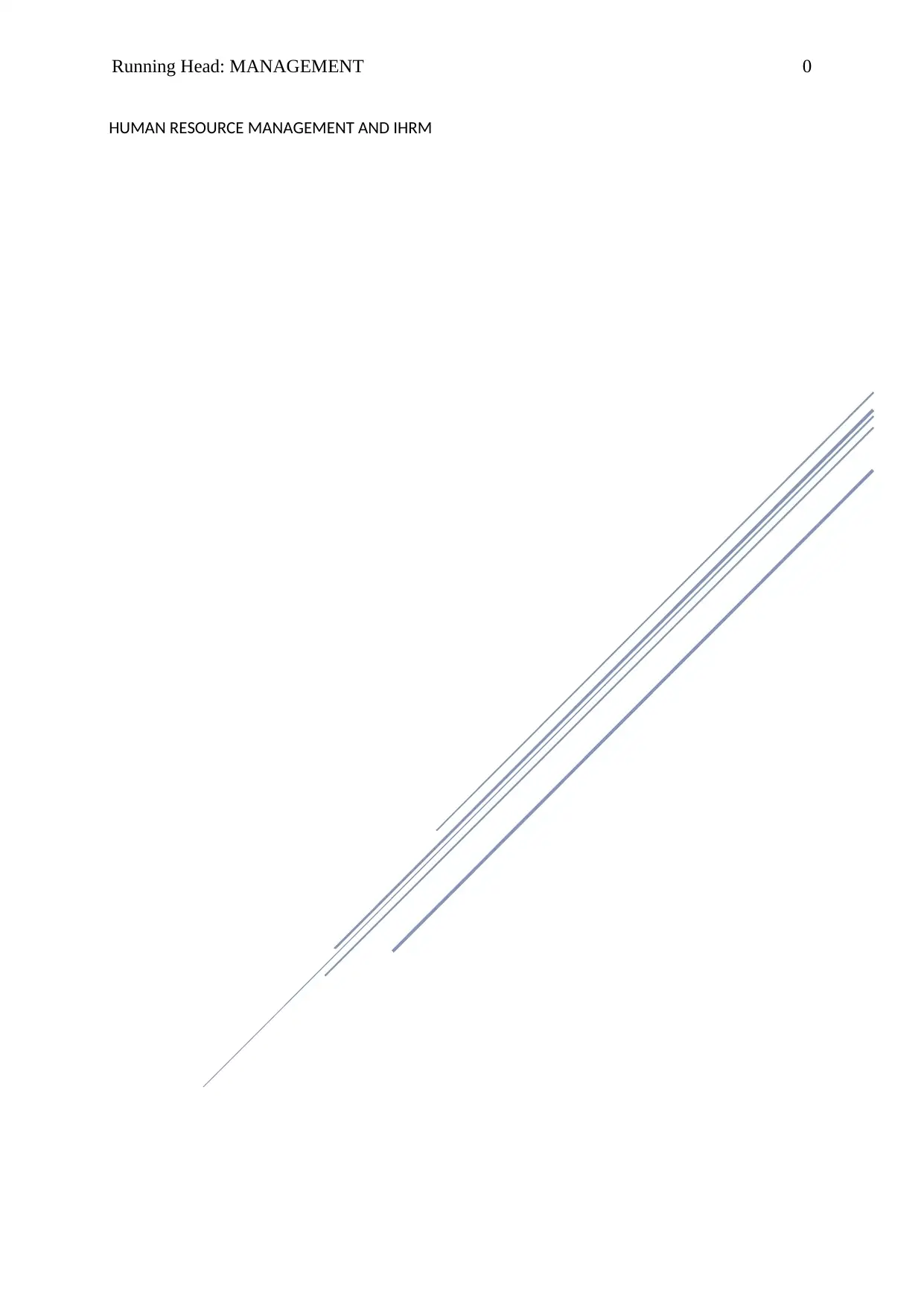
Running Head: MANAGEMENT 0
HUMAN RESOURCE MANAGEMENT AND IHRM
HUMAN RESOURCE MANAGEMENT AND IHRM
Secure Best Marks with AI Grader
Need help grading? Try our AI Grader for instant feedback on your assignments.
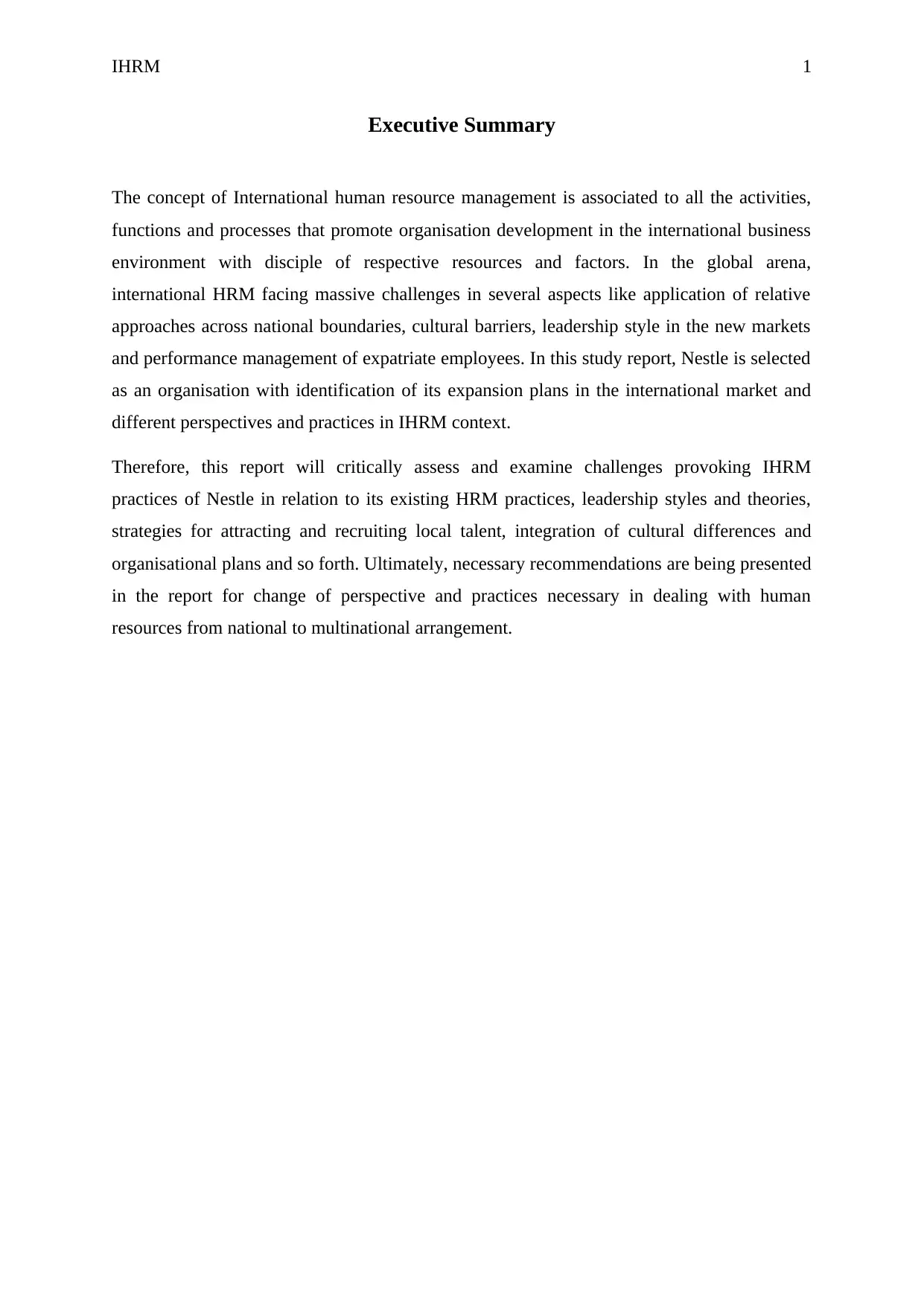
IHRM 1
Executive Summary
The concept of International human resource management is associated to all the activities,
functions and processes that promote organisation development in the international business
environment with disciple of respective resources and factors. In the global arena,
international HRM facing massive challenges in several aspects like application of relative
approaches across national boundaries, cultural barriers, leadership style in the new markets
and performance management of expatriate employees. In this study report, Nestle is selected
as an organisation with identification of its expansion plans in the international market and
different perspectives and practices in IHRM context.
Therefore, this report will critically assess and examine challenges provoking IHRM
practices of Nestle in relation to its existing HRM practices, leadership styles and theories,
strategies for attracting and recruiting local talent, integration of cultural differences and
organisational plans and so forth. Ultimately, necessary recommendations are being presented
in the report for change of perspective and practices necessary in dealing with human
resources from national to multinational arrangement.
Executive Summary
The concept of International human resource management is associated to all the activities,
functions and processes that promote organisation development in the international business
environment with disciple of respective resources and factors. In the global arena,
international HRM facing massive challenges in several aspects like application of relative
approaches across national boundaries, cultural barriers, leadership style in the new markets
and performance management of expatriate employees. In this study report, Nestle is selected
as an organisation with identification of its expansion plans in the international market and
different perspectives and practices in IHRM context.
Therefore, this report will critically assess and examine challenges provoking IHRM
practices of Nestle in relation to its existing HRM practices, leadership styles and theories,
strategies for attracting and recruiting local talent, integration of cultural differences and
organisational plans and so forth. Ultimately, necessary recommendations are being presented
in the report for change of perspective and practices necessary in dealing with human
resources from national to multinational arrangement.
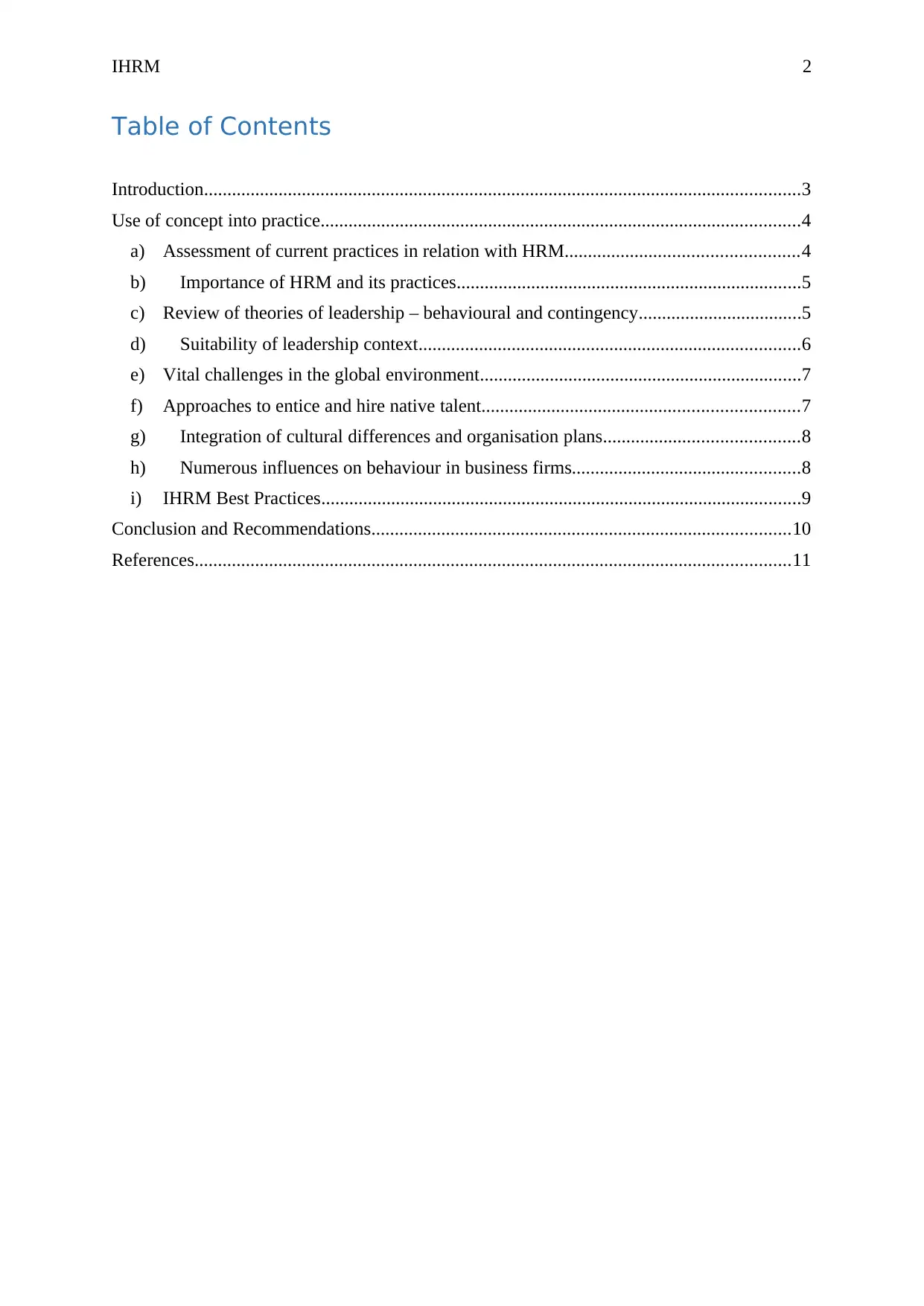
IHRM 2
Table of Contents
Introduction................................................................................................................................3
Use of concept into practice.......................................................................................................4
a) Assessment of current practices in relation with HRM..................................................4
b) Importance of HRM and its practices..........................................................................5
c) Review of theories of leadership – behavioural and contingency...................................5
d) Suitability of leadership context..................................................................................6
e) Vital challenges in the global environment.....................................................................7
f) Approaches to entice and hire native talent....................................................................7
g) Integration of cultural differences and organisation plans..........................................8
h) Numerous influences on behaviour in business firms.................................................8
i) IHRM Best Practices.......................................................................................................9
Conclusion and Recommendations..........................................................................................10
References................................................................................................................................11
Table of Contents
Introduction................................................................................................................................3
Use of concept into practice.......................................................................................................4
a) Assessment of current practices in relation with HRM..................................................4
b) Importance of HRM and its practices..........................................................................5
c) Review of theories of leadership – behavioural and contingency...................................5
d) Suitability of leadership context..................................................................................6
e) Vital challenges in the global environment.....................................................................7
f) Approaches to entice and hire native talent....................................................................7
g) Integration of cultural differences and organisation plans..........................................8
h) Numerous influences on behaviour in business firms.................................................8
i) IHRM Best Practices.......................................................................................................9
Conclusion and Recommendations..........................................................................................10
References................................................................................................................................11
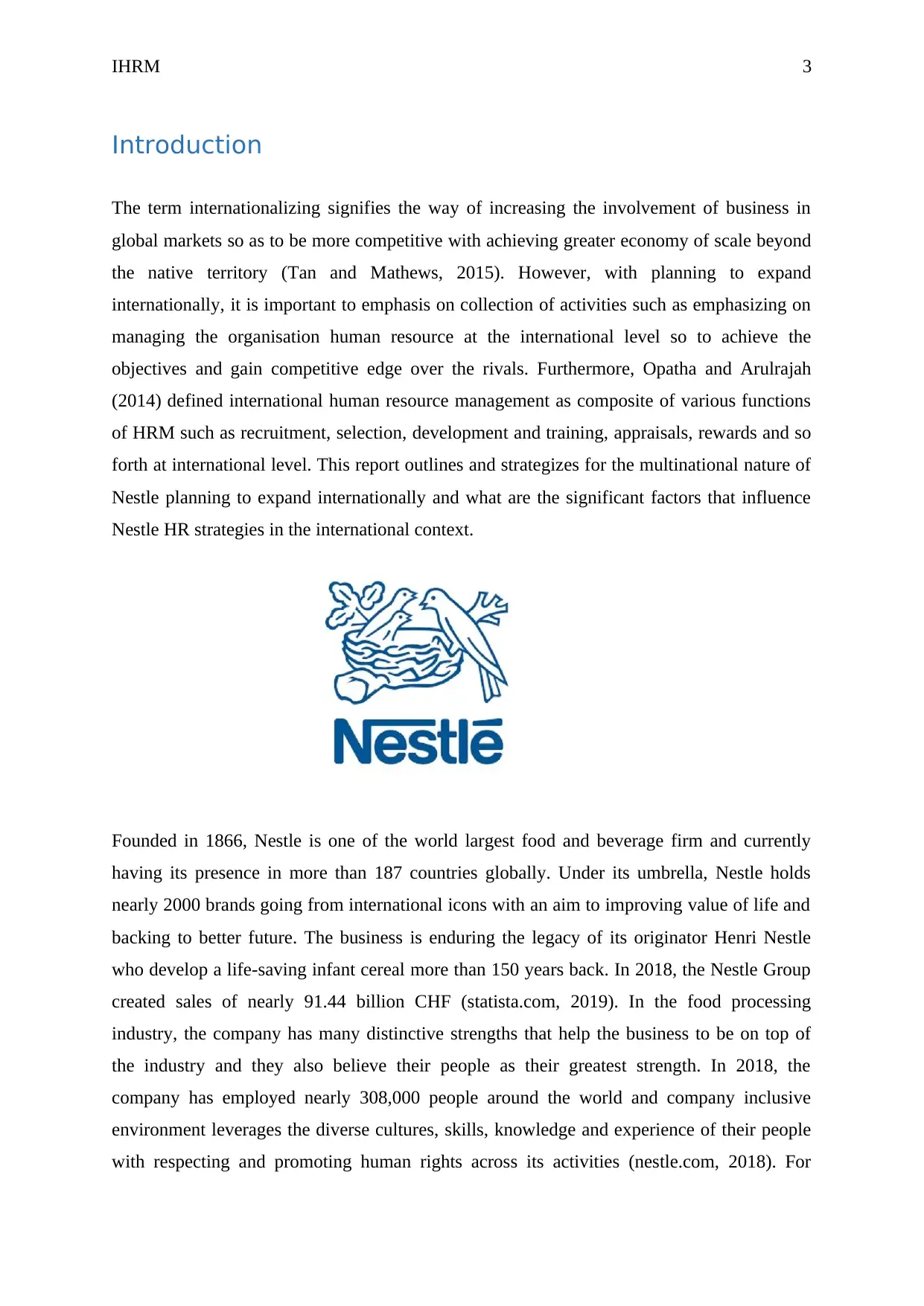
IHRM 3
Introduction
The term internationalizing signifies the way of increasing the involvement of business in
global markets so as to be more competitive with achieving greater economy of scale beyond
the native territory (Tan and Mathews, 2015). However, with planning to expand
internationally, it is important to emphasis on collection of activities such as emphasizing on
managing the organisation human resource at the international level so to achieve the
objectives and gain competitive edge over the rivals. Furthermore, Opatha and Arulrajah
(2014) defined international human resource management as composite of various functions
of HRM such as recruitment, selection, development and training, appraisals, rewards and so
forth at international level. This report outlines and strategizes for the multinational nature of
Nestle planning to expand internationally and what are the significant factors that influence
Nestle HR strategies in the international context.
Founded in 1866, Nestle is one of the world largest food and beverage firm and currently
having its presence in more than 187 countries globally. Under its umbrella, Nestle holds
nearly 2000 brands going from international icons with an aim to improving value of life and
backing to better future. The business is enduring the legacy of its originator Henri Nestle
who develop a life-saving infant cereal more than 150 years back. In 2018, the Nestle Group
created sales of nearly 91.44 billion CHF (statista.com, 2019). In the food processing
industry, the company has many distinctive strengths that help the business to be on top of
the industry and they also believe their people as their greatest strength. In 2018, the
company has employed nearly 308,000 people around the world and company inclusive
environment leverages the diverse cultures, skills, knowledge and experience of their people
with respecting and promoting human rights across its activities (nestle.com, 2018). For
Introduction
The term internationalizing signifies the way of increasing the involvement of business in
global markets so as to be more competitive with achieving greater economy of scale beyond
the native territory (Tan and Mathews, 2015). However, with planning to expand
internationally, it is important to emphasis on collection of activities such as emphasizing on
managing the organisation human resource at the international level so to achieve the
objectives and gain competitive edge over the rivals. Furthermore, Opatha and Arulrajah
(2014) defined international human resource management as composite of various functions
of HRM such as recruitment, selection, development and training, appraisals, rewards and so
forth at international level. This report outlines and strategizes for the multinational nature of
Nestle planning to expand internationally and what are the significant factors that influence
Nestle HR strategies in the international context.
Founded in 1866, Nestle is one of the world largest food and beverage firm and currently
having its presence in more than 187 countries globally. Under its umbrella, Nestle holds
nearly 2000 brands going from international icons with an aim to improving value of life and
backing to better future. The business is enduring the legacy of its originator Henri Nestle
who develop a life-saving infant cereal more than 150 years back. In 2018, the Nestle Group
created sales of nearly 91.44 billion CHF (statista.com, 2019). In the food processing
industry, the company has many distinctive strengths that help the business to be on top of
the industry and they also believe their people as their greatest strength. In 2018, the
company has employed nearly 308,000 people around the world and company inclusive
environment leverages the diverse cultures, skills, knowledge and experience of their people
with respecting and promoting human rights across its activities (nestle.com, 2018). For
Secure Best Marks with AI Grader
Need help grading? Try our AI Grader for instant feedback on your assignments.
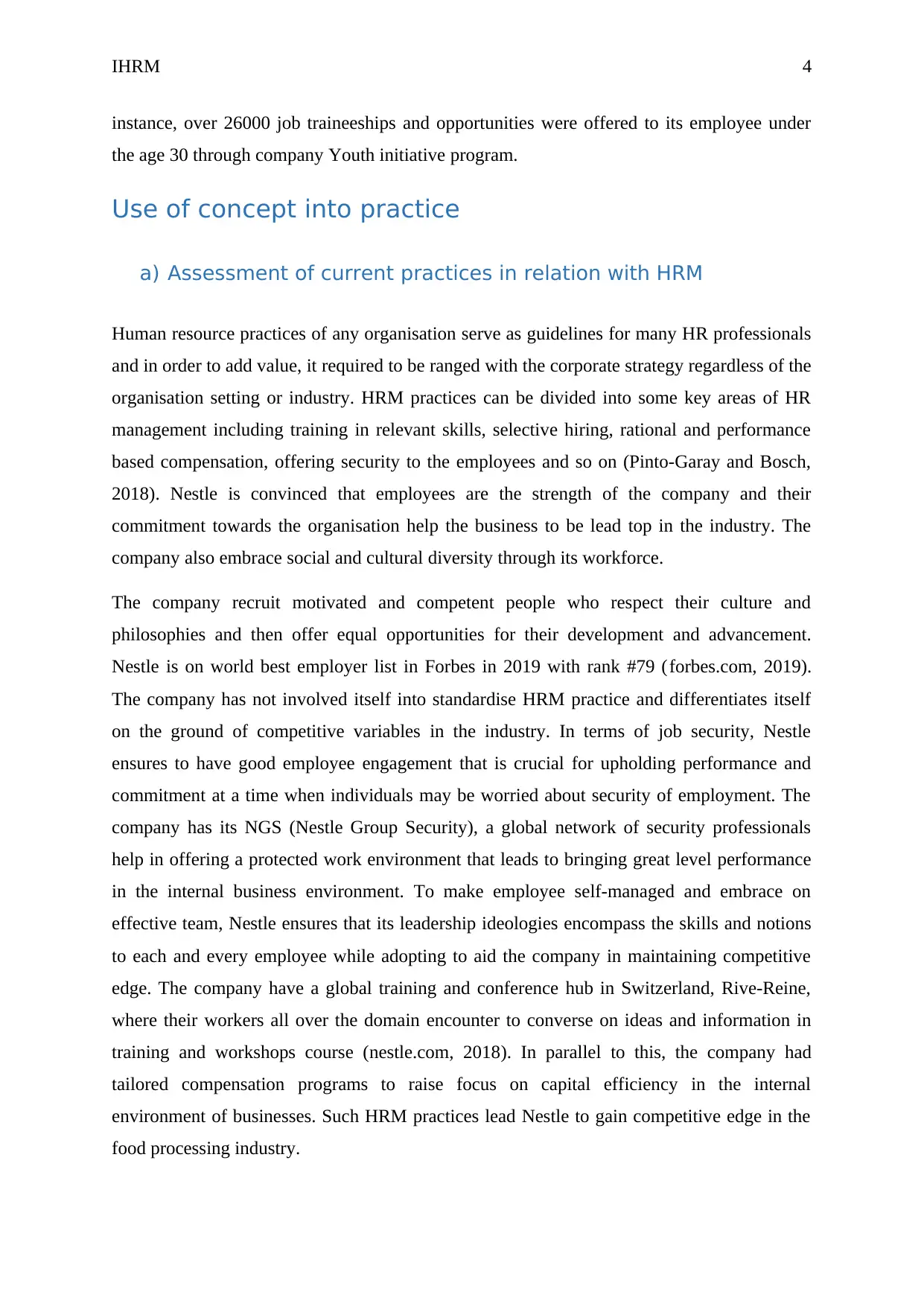
IHRM 4
instance, over 26000 job traineeships and opportunities were offered to its employee under
the age 30 through company Youth initiative program.
Use of concept into practice
a) Assessment of current practices in relation with HRM
Human resource practices of any organisation serve as guidelines for many HR professionals
and in order to add value, it required to be ranged with the corporate strategy regardless of the
organisation setting or industry. HRM practices can be divided into some key areas of HR
management including training in relevant skills, selective hiring, rational and performance
based compensation, offering security to the employees and so on (Pinto-Garay and Bosch,
2018). Nestle is convinced that employees are the strength of the company and their
commitment towards the organisation help the business to be lead top in the industry. The
company also embrace social and cultural diversity through its workforce.
The company recruit motivated and competent people who respect their culture and
philosophies and then offer equal opportunities for their development and advancement.
Nestle is on world best employer list in Forbes in 2019 with rank #79 (forbes.com, 2019).
The company has not involved itself into standardise HRM practice and differentiates itself
on the ground of competitive variables in the industry. In terms of job security, Nestle
ensures to have good employee engagement that is crucial for upholding performance and
commitment at a time when individuals may be worried about security of employment. The
company has its NGS (Nestle Group Security), a global network of security professionals
help in offering a protected work environment that leads to bringing great level performance
in the internal business environment. To make employee self-managed and embrace on
effective team, Nestle ensures that its leadership ideologies encompass the skills and notions
to each and every employee while adopting to aid the company in maintaining competitive
edge. The company have a global training and conference hub in Switzerland, Rive-Reine,
where their workers all over the domain encounter to converse on ideas and information in
training and workshops course (nestle.com, 2018). In parallel to this, the company had
tailored compensation programs to raise focus on capital efficiency in the internal
environment of businesses. Such HRM practices lead Nestle to gain competitive edge in the
food processing industry.
instance, over 26000 job traineeships and opportunities were offered to its employee under
the age 30 through company Youth initiative program.
Use of concept into practice
a) Assessment of current practices in relation with HRM
Human resource practices of any organisation serve as guidelines for many HR professionals
and in order to add value, it required to be ranged with the corporate strategy regardless of the
organisation setting or industry. HRM practices can be divided into some key areas of HR
management including training in relevant skills, selective hiring, rational and performance
based compensation, offering security to the employees and so on (Pinto-Garay and Bosch,
2018). Nestle is convinced that employees are the strength of the company and their
commitment towards the organisation help the business to be lead top in the industry. The
company also embrace social and cultural diversity through its workforce.
The company recruit motivated and competent people who respect their culture and
philosophies and then offer equal opportunities for their development and advancement.
Nestle is on world best employer list in Forbes in 2019 with rank #79 (forbes.com, 2019).
The company has not involved itself into standardise HRM practice and differentiates itself
on the ground of competitive variables in the industry. In terms of job security, Nestle
ensures to have good employee engagement that is crucial for upholding performance and
commitment at a time when individuals may be worried about security of employment. The
company has its NGS (Nestle Group Security), a global network of security professionals
help in offering a protected work environment that leads to bringing great level performance
in the internal business environment. To make employee self-managed and embrace on
effective team, Nestle ensures that its leadership ideologies encompass the skills and notions
to each and every employee while adopting to aid the company in maintaining competitive
edge. The company have a global training and conference hub in Switzerland, Rive-Reine,
where their workers all over the domain encounter to converse on ideas and information in
training and workshops course (nestle.com, 2018). In parallel to this, the company had
tailored compensation programs to raise focus on capital efficiency in the internal
environment of businesses. Such HRM practices lead Nestle to gain competitive edge in the
food processing industry.
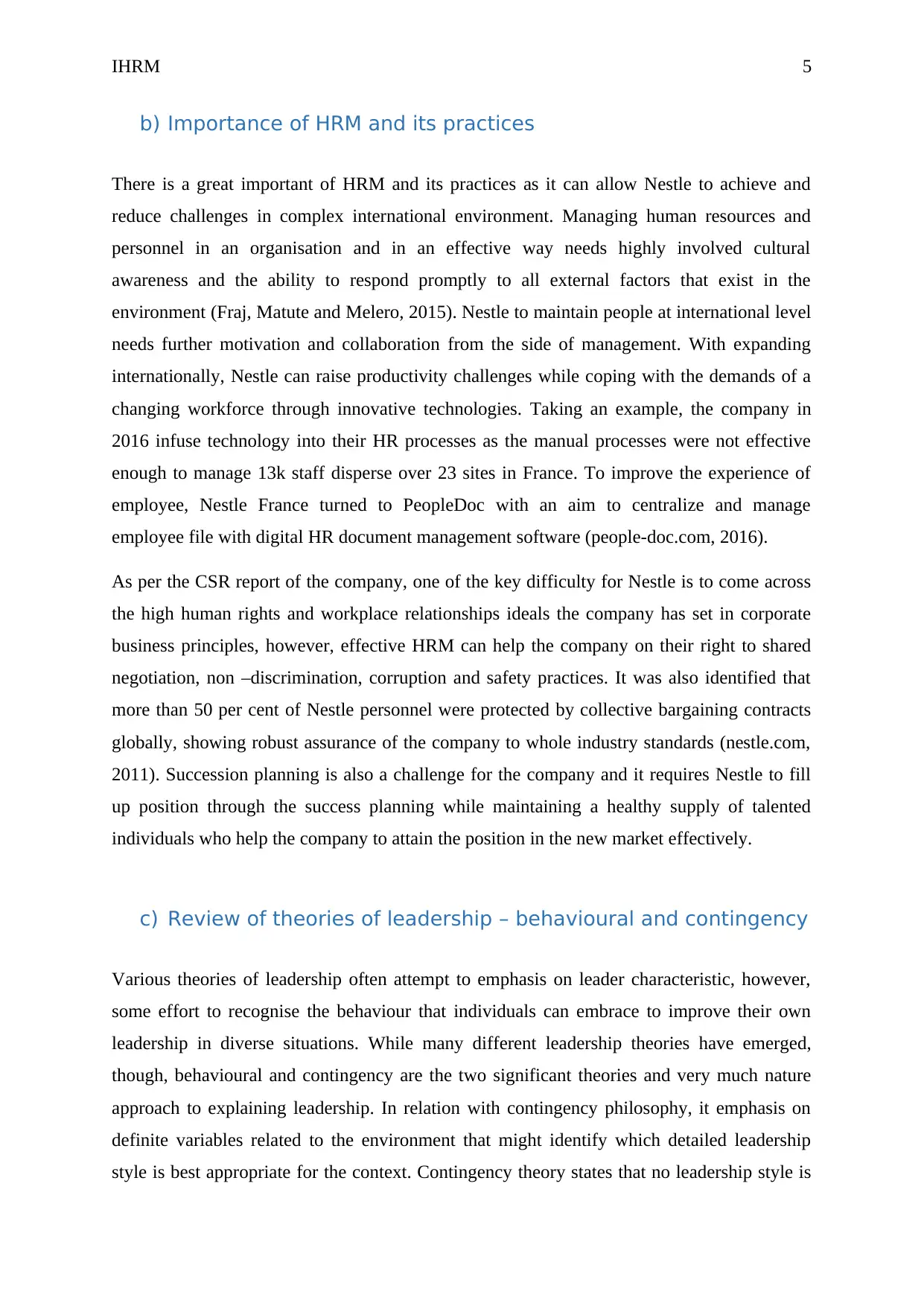
IHRM 5
b) Importance of HRM and its practices
There is a great important of HRM and its practices as it can allow Nestle to achieve and
reduce challenges in complex international environment. Managing human resources and
personnel in an organisation and in an effective way needs highly involved cultural
awareness and the ability to respond promptly to all external factors that exist in the
environment (Fraj, Matute and Melero, 2015). Nestle to maintain people at international level
needs further motivation and collaboration from the side of management. With expanding
internationally, Nestle can raise productivity challenges while coping with the demands of a
changing workforce through innovative technologies. Taking an example, the company in
2016 infuse technology into their HR processes as the manual processes were not effective
enough to manage 13k staff disperse over 23 sites in France. To improve the experience of
employee, Nestle France turned to PeopleDoc with an aim to centralize and manage
employee file with digital HR document management software (people-doc.com, 2016).
As per the CSR report of the company, one of the key difficulty for Nestle is to come across
the high human rights and workplace relationships ideals the company has set in corporate
business principles, however, effective HRM can help the company on their right to shared
negotiation, non –discrimination, corruption and safety practices. It was also identified that
more than 50 per cent of Nestle personnel were protected by collective bargaining contracts
globally, showing robust assurance of the company to whole industry standards (nestle.com,
2011). Succession planning is also a challenge for the company and it requires Nestle to fill
up position through the success planning while maintaining a healthy supply of talented
individuals who help the company to attain the position in the new market effectively.
c) Review of theories of leadership – behavioural and contingency
Various theories of leadership often attempt to emphasis on leader characteristic, however,
some effort to recognise the behaviour that individuals can embrace to improve their own
leadership in diverse situations. While many different leadership theories have emerged,
though, behavioural and contingency are the two significant theories and very much nature
approach to explaining leadership. In relation with contingency philosophy, it emphasis on
definite variables related to the environment that might identify which detailed leadership
style is best appropriate for the context. Contingency theory states that no leadership style is
b) Importance of HRM and its practices
There is a great important of HRM and its practices as it can allow Nestle to achieve and
reduce challenges in complex international environment. Managing human resources and
personnel in an organisation and in an effective way needs highly involved cultural
awareness and the ability to respond promptly to all external factors that exist in the
environment (Fraj, Matute and Melero, 2015). Nestle to maintain people at international level
needs further motivation and collaboration from the side of management. With expanding
internationally, Nestle can raise productivity challenges while coping with the demands of a
changing workforce through innovative technologies. Taking an example, the company in
2016 infuse technology into their HR processes as the manual processes were not effective
enough to manage 13k staff disperse over 23 sites in France. To improve the experience of
employee, Nestle France turned to PeopleDoc with an aim to centralize and manage
employee file with digital HR document management software (people-doc.com, 2016).
As per the CSR report of the company, one of the key difficulty for Nestle is to come across
the high human rights and workplace relationships ideals the company has set in corporate
business principles, however, effective HRM can help the company on their right to shared
negotiation, non –discrimination, corruption and safety practices. It was also identified that
more than 50 per cent of Nestle personnel were protected by collective bargaining contracts
globally, showing robust assurance of the company to whole industry standards (nestle.com,
2011). Succession planning is also a challenge for the company and it requires Nestle to fill
up position through the success planning while maintaining a healthy supply of talented
individuals who help the company to attain the position in the new market effectively.
c) Review of theories of leadership – behavioural and contingency
Various theories of leadership often attempt to emphasis on leader characteristic, however,
some effort to recognise the behaviour that individuals can embrace to improve their own
leadership in diverse situations. While many different leadership theories have emerged,
though, behavioural and contingency are the two significant theories and very much nature
approach to explaining leadership. In relation with contingency philosophy, it emphasis on
definite variables related to the environment that might identify which detailed leadership
style is best appropriate for the context. Contingency theory states that no leadership style is
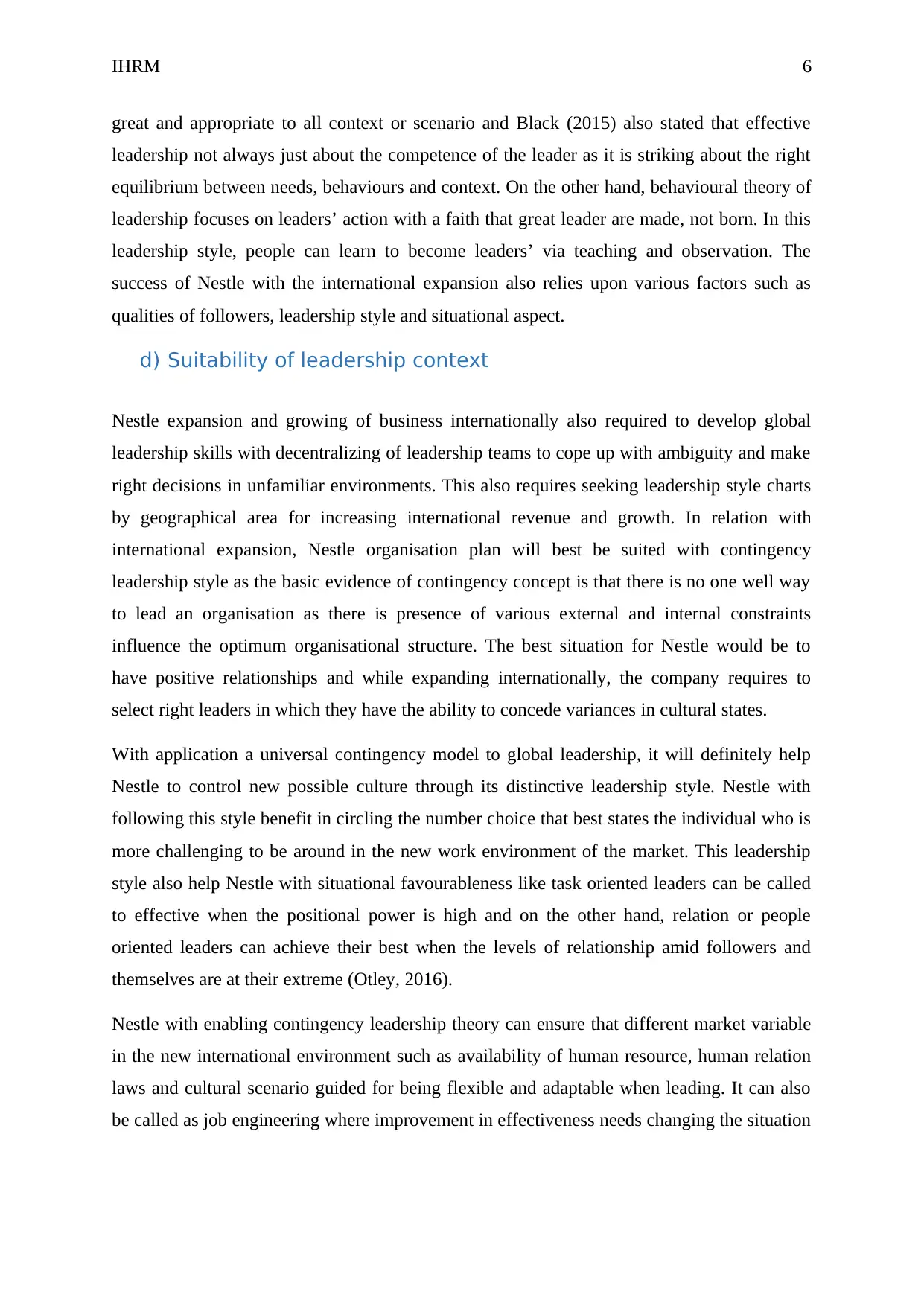
IHRM 6
great and appropriate to all context or scenario and Black (2015) also stated that effective
leadership not always just about the competence of the leader as it is striking about the right
equilibrium between needs, behaviours and context. On the other hand, behavioural theory of
leadership focuses on leaders’ action with a faith that great leader are made, not born. In this
leadership style, people can learn to become leaders’ via teaching and observation. The
success of Nestle with the international expansion also relies upon various factors such as
qualities of followers, leadership style and situational aspect.
d) Suitability of leadership context
Nestle expansion and growing of business internationally also required to develop global
leadership skills with decentralizing of leadership teams to cope up with ambiguity and make
right decisions in unfamiliar environments. This also requires seeking leadership style charts
by geographical area for increasing international revenue and growth. In relation with
international expansion, Nestle organisation plan will best be suited with contingency
leadership style as the basic evidence of contingency concept is that there is no one well way
to lead an organisation as there is presence of various external and internal constraints
influence the optimum organisational structure. The best situation for Nestle would be to
have positive relationships and while expanding internationally, the company requires to
select right leaders in which they have the ability to concede variances in cultural states.
With application a universal contingency model to global leadership, it will definitely help
Nestle to control new possible culture through its distinctive leadership style. Nestle with
following this style benefit in circling the number choice that best states the individual who is
more challenging to be around in the new work environment of the market. This leadership
style also help Nestle with situational favourableness like task oriented leaders can be called
to effective when the positional power is high and on the other hand, relation or people
oriented leaders can achieve their best when the levels of relationship amid followers and
themselves are at their extreme (Otley, 2016).
Nestle with enabling contingency leadership theory can ensure that different market variable
in the new international environment such as availability of human resource, human relation
laws and cultural scenario guided for being flexible and adaptable when leading. It can also
be called as job engineering where improvement in effectiveness needs changing the situation
great and appropriate to all context or scenario and Black (2015) also stated that effective
leadership not always just about the competence of the leader as it is striking about the right
equilibrium between needs, behaviours and context. On the other hand, behavioural theory of
leadership focuses on leaders’ action with a faith that great leader are made, not born. In this
leadership style, people can learn to become leaders’ via teaching and observation. The
success of Nestle with the international expansion also relies upon various factors such as
qualities of followers, leadership style and situational aspect.
d) Suitability of leadership context
Nestle expansion and growing of business internationally also required to develop global
leadership skills with decentralizing of leadership teams to cope up with ambiguity and make
right decisions in unfamiliar environments. This also requires seeking leadership style charts
by geographical area for increasing international revenue and growth. In relation with
international expansion, Nestle organisation plan will best be suited with contingency
leadership style as the basic evidence of contingency concept is that there is no one well way
to lead an organisation as there is presence of various external and internal constraints
influence the optimum organisational structure. The best situation for Nestle would be to
have positive relationships and while expanding internationally, the company requires to
select right leaders in which they have the ability to concede variances in cultural states.
With application a universal contingency model to global leadership, it will definitely help
Nestle to control new possible culture through its distinctive leadership style. Nestle with
following this style benefit in circling the number choice that best states the individual who is
more challenging to be around in the new work environment of the market. This leadership
style also help Nestle with situational favourableness like task oriented leaders can be called
to effective when the positional power is high and on the other hand, relation or people
oriented leaders can achieve their best when the levels of relationship amid followers and
themselves are at their extreme (Otley, 2016).
Nestle with enabling contingency leadership theory can ensure that different market variable
in the new international environment such as availability of human resource, human relation
laws and cultural scenario guided for being flexible and adaptable when leading. It can also
be called as job engineering where improvement in effectiveness needs changing the situation
Paraphrase This Document
Need a fresh take? Get an instant paraphrase of this document with our AI Paraphraser
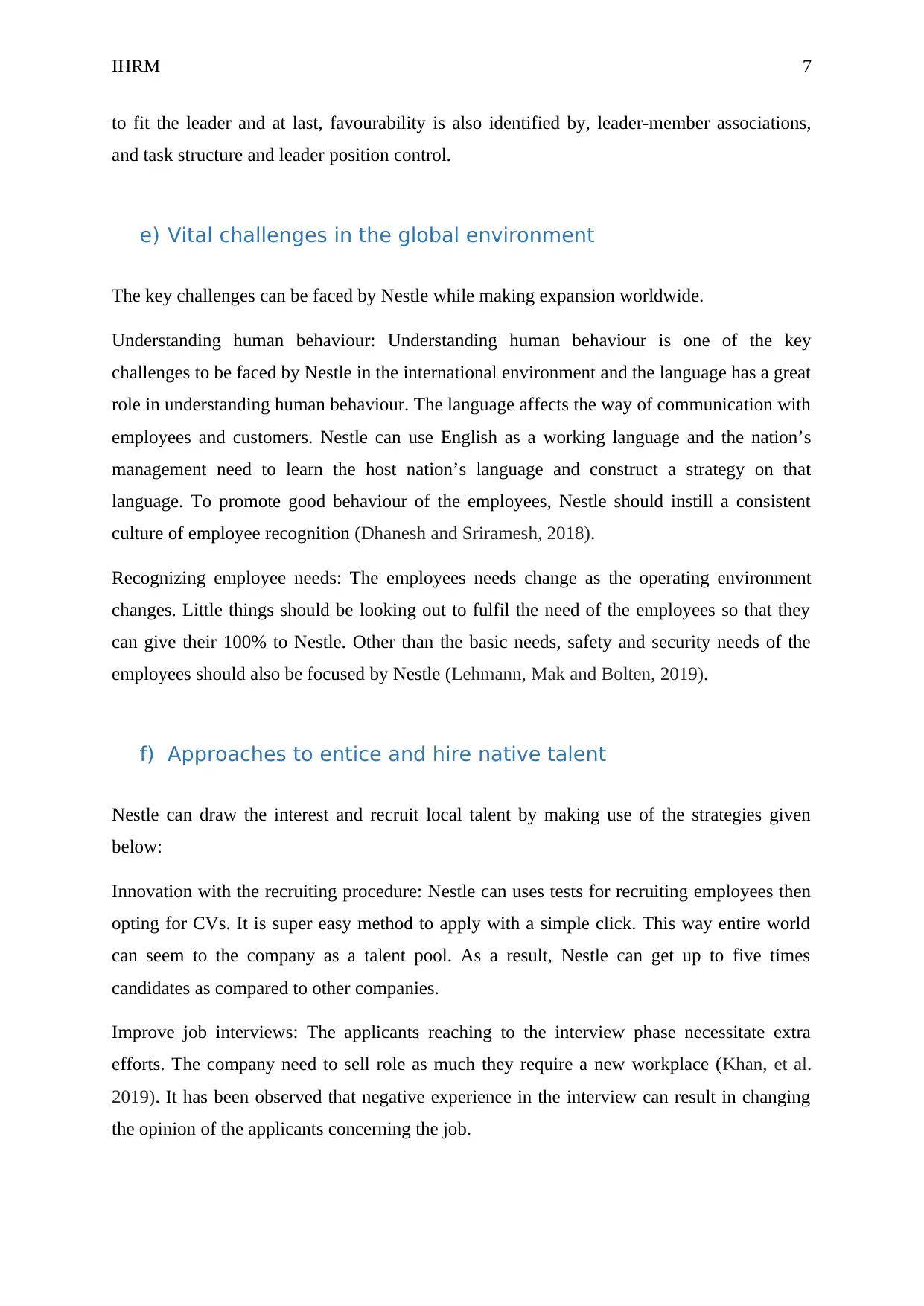
IHRM 7
to fit the leader and at last, favourability is also identified by, leader-member associations,
and task structure and leader position control.
e) Vital challenges in the global environment
The key challenges can be faced by Nestle while making expansion worldwide.
Understanding human behaviour: Understanding human behaviour is one of the key
challenges to be faced by Nestle in the international environment and the language has a great
role in understanding human behaviour. The language affects the way of communication with
employees and customers. Nestle can use English as a working language and the nation’s
management need to learn the host nation’s language and construct a strategy on that
language. To promote good behaviour of the employees, Nestle should instill a consistent
culture of employee recognition (Dhanesh and Sriramesh, 2018).
Recognizing employee needs: The employees needs change as the operating environment
changes. Little things should be looking out to fulfil the need of the employees so that they
can give their 100% to Nestle. Other than the basic needs, safety and security needs of the
employees should also be focused by Nestle (Lehmann, Mak and Bolten, 2019).
f) Approaches to entice and hire native talent
Nestle can draw the interest and recruit local talent by making use of the strategies given
below:
Innovation with the recruiting procedure: Nestle can uses tests for recruiting employees then
opting for CVs. It is super easy method to apply with a simple click. This way entire world
can seem to the company as a talent pool. As a result, Nestle can get up to five times
candidates as compared to other companies.
Improve job interviews: The applicants reaching to the interview phase necessitate extra
efforts. The company need to sell role as much they require a new workplace (Khan, et al.
2019). It has been observed that negative experience in the interview can result in changing
the opinion of the applicants concerning the job.
to fit the leader and at last, favourability is also identified by, leader-member associations,
and task structure and leader position control.
e) Vital challenges in the global environment
The key challenges can be faced by Nestle while making expansion worldwide.
Understanding human behaviour: Understanding human behaviour is one of the key
challenges to be faced by Nestle in the international environment and the language has a great
role in understanding human behaviour. The language affects the way of communication with
employees and customers. Nestle can use English as a working language and the nation’s
management need to learn the host nation’s language and construct a strategy on that
language. To promote good behaviour of the employees, Nestle should instill a consistent
culture of employee recognition (Dhanesh and Sriramesh, 2018).
Recognizing employee needs: The employees needs change as the operating environment
changes. Little things should be looking out to fulfil the need of the employees so that they
can give their 100% to Nestle. Other than the basic needs, safety and security needs of the
employees should also be focused by Nestle (Lehmann, Mak and Bolten, 2019).
f) Approaches to entice and hire native talent
Nestle can draw the interest and recruit local talent by making use of the strategies given
below:
Innovation with the recruiting procedure: Nestle can uses tests for recruiting employees then
opting for CVs. It is super easy method to apply with a simple click. This way entire world
can seem to the company as a talent pool. As a result, Nestle can get up to five times
candidates as compared to other companies.
Improve job interviews: The applicants reaching to the interview phase necessitate extra
efforts. The company need to sell role as much they require a new workplace (Khan, et al.
2019). It has been observed that negative experience in the interview can result in changing
the opinion of the applicants concerning the job.
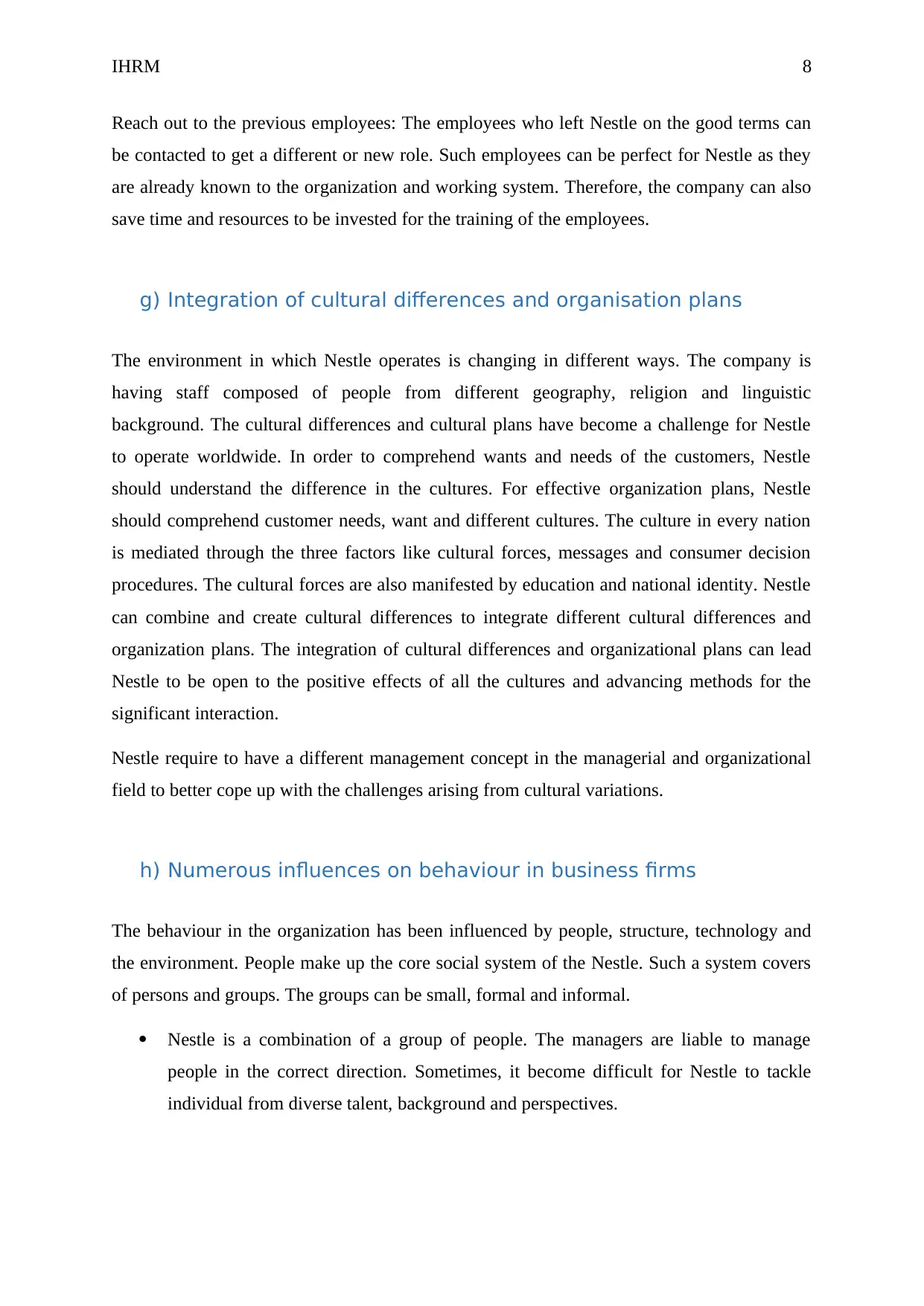
IHRM 8
Reach out to the previous employees: The employees who left Nestle on the good terms can
be contacted to get a different or new role. Such employees can be perfect for Nestle as they
are already known to the organization and working system. Therefore, the company can also
save time and resources to be invested for the training of the employees.
g) Integration of cultural differences and organisation plans
The environment in which Nestle operates is changing in different ways. The company is
having staff composed of people from different geography, religion and linguistic
background. The cultural differences and cultural plans have become a challenge for Nestle
to operate worldwide. In order to comprehend wants and needs of the customers, Nestle
should understand the difference in the cultures. For effective organization plans, Nestle
should comprehend customer needs, want and different cultures. The culture in every nation
is mediated through the three factors like cultural forces, messages and consumer decision
procedures. The cultural forces are also manifested by education and national identity. Nestle
can combine and create cultural differences to integrate different cultural differences and
organization plans. The integration of cultural differences and organizational plans can lead
Nestle to be open to the positive effects of all the cultures and advancing methods for the
significant interaction.
Nestle require to have a different management concept in the managerial and organizational
field to better cope up with the challenges arising from cultural variations.
h) Numerous influences on behaviour in business firms
The behaviour in the organization has been influenced by people, structure, technology and
the environment. People make up the core social system of the Nestle. Such a system covers
of persons and groups. The groups can be small, formal and informal.
Nestle is a combination of a group of people. The managers are liable to manage
people in the correct direction. Sometimes, it become difficult for Nestle to tackle
individual from diverse talent, background and perspectives.
Reach out to the previous employees: The employees who left Nestle on the good terms can
be contacted to get a different or new role. Such employees can be perfect for Nestle as they
are already known to the organization and working system. Therefore, the company can also
save time and resources to be invested for the training of the employees.
g) Integration of cultural differences and organisation plans
The environment in which Nestle operates is changing in different ways. The company is
having staff composed of people from different geography, religion and linguistic
background. The cultural differences and cultural plans have become a challenge for Nestle
to operate worldwide. In order to comprehend wants and needs of the customers, Nestle
should understand the difference in the cultures. For effective organization plans, Nestle
should comprehend customer needs, want and different cultures. The culture in every nation
is mediated through the three factors like cultural forces, messages and consumer decision
procedures. The cultural forces are also manifested by education and national identity. Nestle
can combine and create cultural differences to integrate different cultural differences and
organization plans. The integration of cultural differences and organizational plans can lead
Nestle to be open to the positive effects of all the cultures and advancing methods for the
significant interaction.
Nestle require to have a different management concept in the managerial and organizational
field to better cope up with the challenges arising from cultural variations.
h) Numerous influences on behaviour in business firms
The behaviour in the organization has been influenced by people, structure, technology and
the environment. People make up the core social system of the Nestle. Such a system covers
of persons and groups. The groups can be small, formal and informal.
Nestle is a combination of a group of people. The managers are liable to manage
people in the correct direction. Sometimes, it become difficult for Nestle to tackle
individual from diverse talent, background and perspectives.
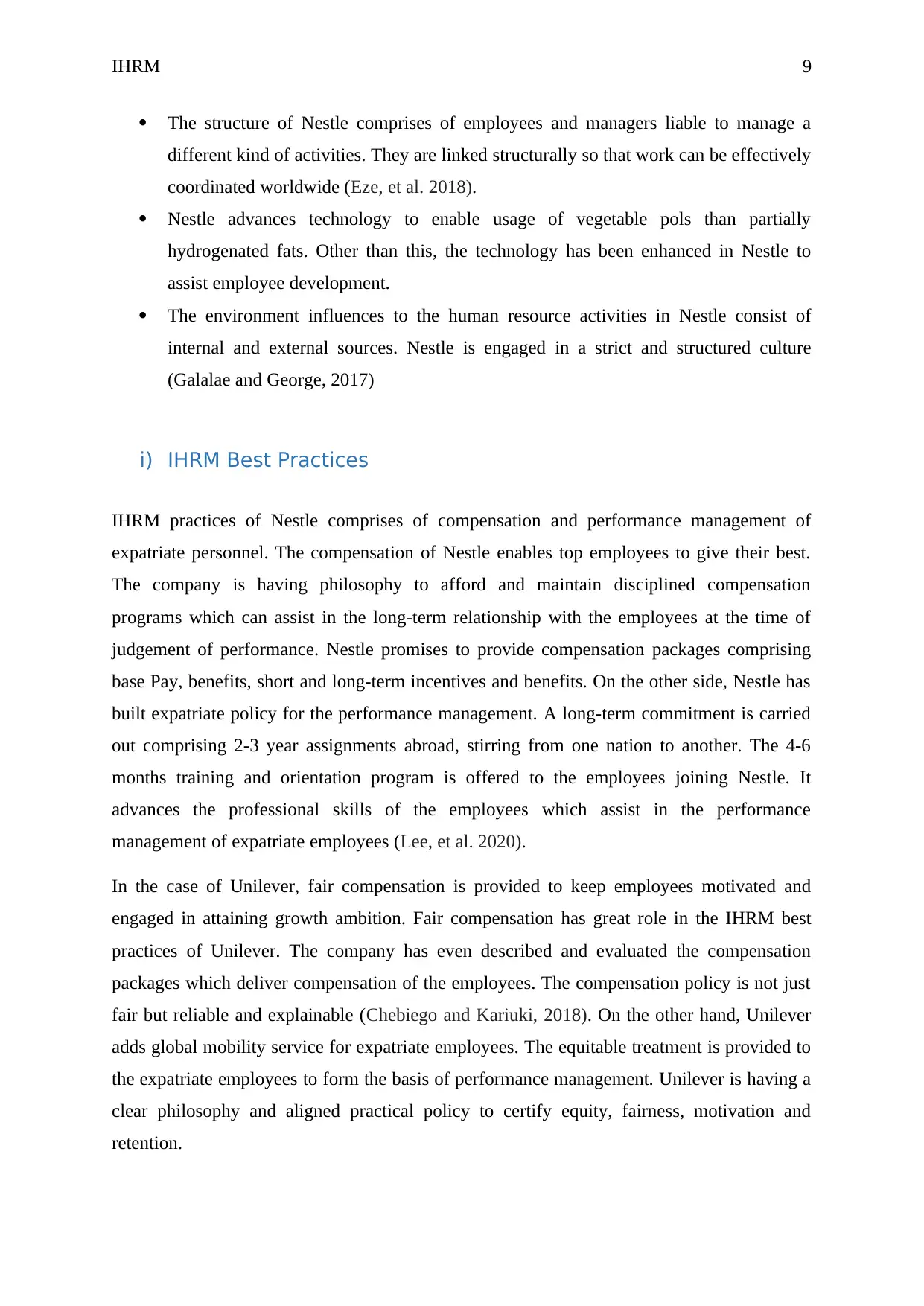
IHRM 9
The structure of Nestle comprises of employees and managers liable to manage a
different kind of activities. They are linked structurally so that work can be effectively
coordinated worldwide (Eze, et al. 2018).
Nestle advances technology to enable usage of vegetable pols than partially
hydrogenated fats. Other than this, the technology has been enhanced in Nestle to
assist employee development.
The environment influences to the human resource activities in Nestle consist of
internal and external sources. Nestle is engaged in a strict and structured culture
(Galalae and George, 2017)
i) IHRM Best Practices
IHRM practices of Nestle comprises of compensation and performance management of
expatriate personnel. The compensation of Nestle enables top employees to give their best.
The company is having philosophy to afford and maintain disciplined compensation
programs which can assist in the long-term relationship with the employees at the time of
judgement of performance. Nestle promises to provide compensation packages comprising
base Pay, benefits, short and long-term incentives and benefits. On the other side, Nestle has
built expatriate policy for the performance management. A long-term commitment is carried
out comprising 2-3 year assignments abroad, stirring from one nation to another. The 4-6
months training and orientation program is offered to the employees joining Nestle. It
advances the professional skills of the employees which assist in the performance
management of expatriate employees (Lee, et al. 2020).
In the case of Unilever, fair compensation is provided to keep employees motivated and
engaged in attaining growth ambition. Fair compensation has great role in the IHRM best
practices of Unilever. The company has even described and evaluated the compensation
packages which deliver compensation of the employees. The compensation policy is not just
fair but reliable and explainable (Chebiego and Kariuki, 2018). On the other hand, Unilever
adds global mobility service for expatriate employees. The equitable treatment is provided to
the expatriate employees to form the basis of performance management. Unilever is having a
clear philosophy and aligned practical policy to certify equity, fairness, motivation and
retention.
The structure of Nestle comprises of employees and managers liable to manage a
different kind of activities. They are linked structurally so that work can be effectively
coordinated worldwide (Eze, et al. 2018).
Nestle advances technology to enable usage of vegetable pols than partially
hydrogenated fats. Other than this, the technology has been enhanced in Nestle to
assist employee development.
The environment influences to the human resource activities in Nestle consist of
internal and external sources. Nestle is engaged in a strict and structured culture
(Galalae and George, 2017)
i) IHRM Best Practices
IHRM practices of Nestle comprises of compensation and performance management of
expatriate personnel. The compensation of Nestle enables top employees to give their best.
The company is having philosophy to afford and maintain disciplined compensation
programs which can assist in the long-term relationship with the employees at the time of
judgement of performance. Nestle promises to provide compensation packages comprising
base Pay, benefits, short and long-term incentives and benefits. On the other side, Nestle has
built expatriate policy for the performance management. A long-term commitment is carried
out comprising 2-3 year assignments abroad, stirring from one nation to another. The 4-6
months training and orientation program is offered to the employees joining Nestle. It
advances the professional skills of the employees which assist in the performance
management of expatriate employees (Lee, et al. 2020).
In the case of Unilever, fair compensation is provided to keep employees motivated and
engaged in attaining growth ambition. Fair compensation has great role in the IHRM best
practices of Unilever. The company has even described and evaluated the compensation
packages which deliver compensation of the employees. The compensation policy is not just
fair but reliable and explainable (Chebiego and Kariuki, 2018). On the other hand, Unilever
adds global mobility service for expatriate employees. The equitable treatment is provided to
the expatriate employees to form the basis of performance management. Unilever is having a
clear philosophy and aligned practical policy to certify equity, fairness, motivation and
retention.
Secure Best Marks with AI Grader
Need help grading? Try our AI Grader for instant feedback on your assignments.

IHRM 10
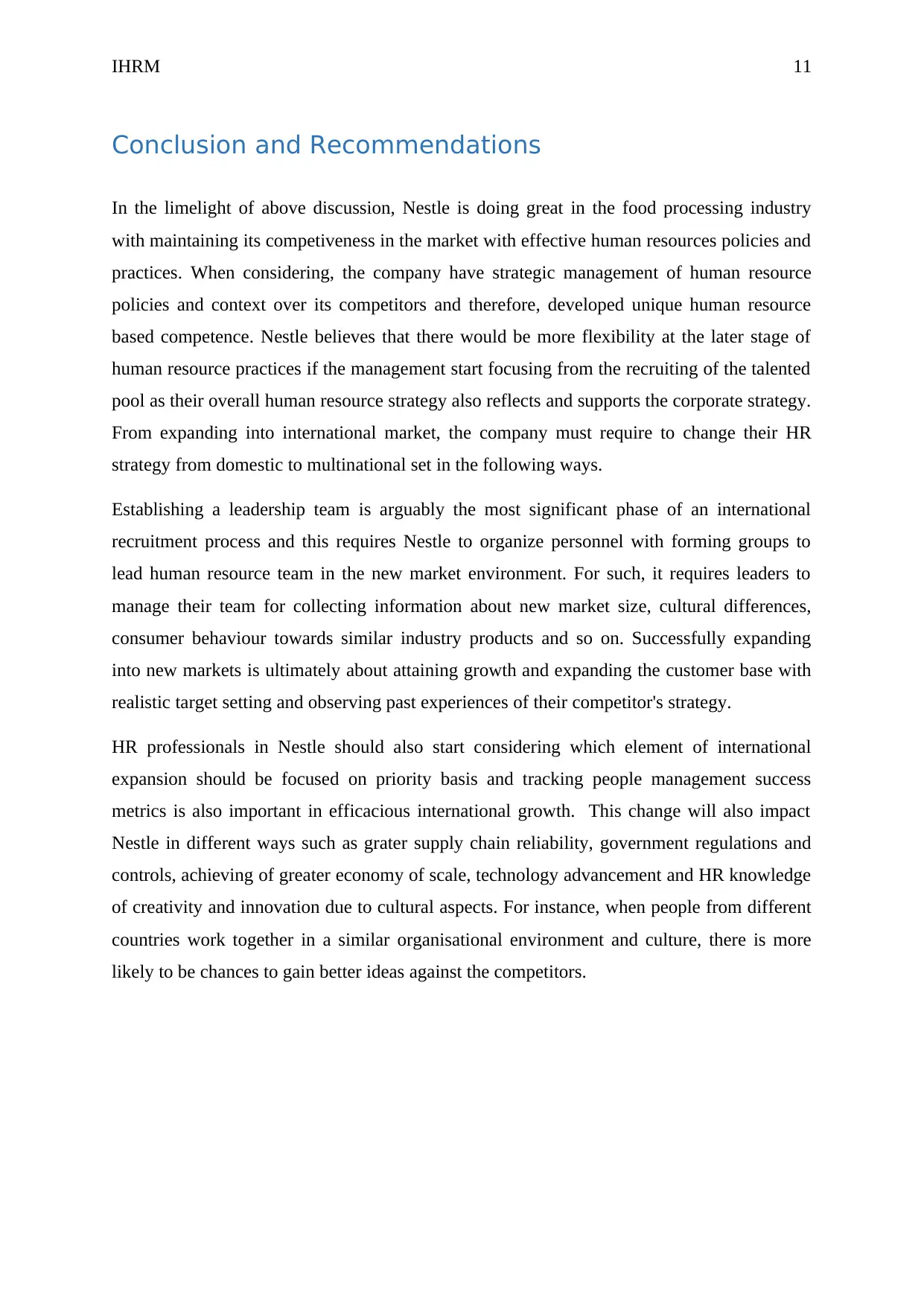
IHRM 11
Conclusion and Recommendations
In the limelight of above discussion, Nestle is doing great in the food processing industry
with maintaining its competiveness in the market with effective human resources policies and
practices. When considering, the company have strategic management of human resource
policies and context over its competitors and therefore, developed unique human resource
based competence. Nestle believes that there would be more flexibility at the later stage of
human resource practices if the management start focusing from the recruiting of the talented
pool as their overall human resource strategy also reflects and supports the corporate strategy.
From expanding into international market, the company must require to change their HR
strategy from domestic to multinational set in the following ways.
Establishing a leadership team is arguably the most significant phase of an international
recruitment process and this requires Nestle to organize personnel with forming groups to
lead human resource team in the new market environment. For such, it requires leaders to
manage their team for collecting information about new market size, cultural differences,
consumer behaviour towards similar industry products and so on. Successfully expanding
into new markets is ultimately about attaining growth and expanding the customer base with
realistic target setting and observing past experiences of their competitor's strategy.
HR professionals in Nestle should also start considering which element of international
expansion should be focused on priority basis and tracking people management success
metrics is also important in efficacious international growth. This change will also impact
Nestle in different ways such as grater supply chain reliability, government regulations and
controls, achieving of greater economy of scale, technology advancement and HR knowledge
of creativity and innovation due to cultural aspects. For instance, when people from different
countries work together in a similar organisational environment and culture, there is more
likely to be chances to gain better ideas against the competitors.
Conclusion and Recommendations
In the limelight of above discussion, Nestle is doing great in the food processing industry
with maintaining its competiveness in the market with effective human resources policies and
practices. When considering, the company have strategic management of human resource
policies and context over its competitors and therefore, developed unique human resource
based competence. Nestle believes that there would be more flexibility at the later stage of
human resource practices if the management start focusing from the recruiting of the talented
pool as their overall human resource strategy also reflects and supports the corporate strategy.
From expanding into international market, the company must require to change their HR
strategy from domestic to multinational set in the following ways.
Establishing a leadership team is arguably the most significant phase of an international
recruitment process and this requires Nestle to organize personnel with forming groups to
lead human resource team in the new market environment. For such, it requires leaders to
manage their team for collecting information about new market size, cultural differences,
consumer behaviour towards similar industry products and so on. Successfully expanding
into new markets is ultimately about attaining growth and expanding the customer base with
realistic target setting and observing past experiences of their competitor's strategy.
HR professionals in Nestle should also start considering which element of international
expansion should be focused on priority basis and tracking people management success
metrics is also important in efficacious international growth. This change will also impact
Nestle in different ways such as grater supply chain reliability, government regulations and
controls, achieving of greater economy of scale, technology advancement and HR knowledge
of creativity and innovation due to cultural aspects. For instance, when people from different
countries work together in a similar organisational environment and culture, there is more
likely to be chances to gain better ideas against the competitors.
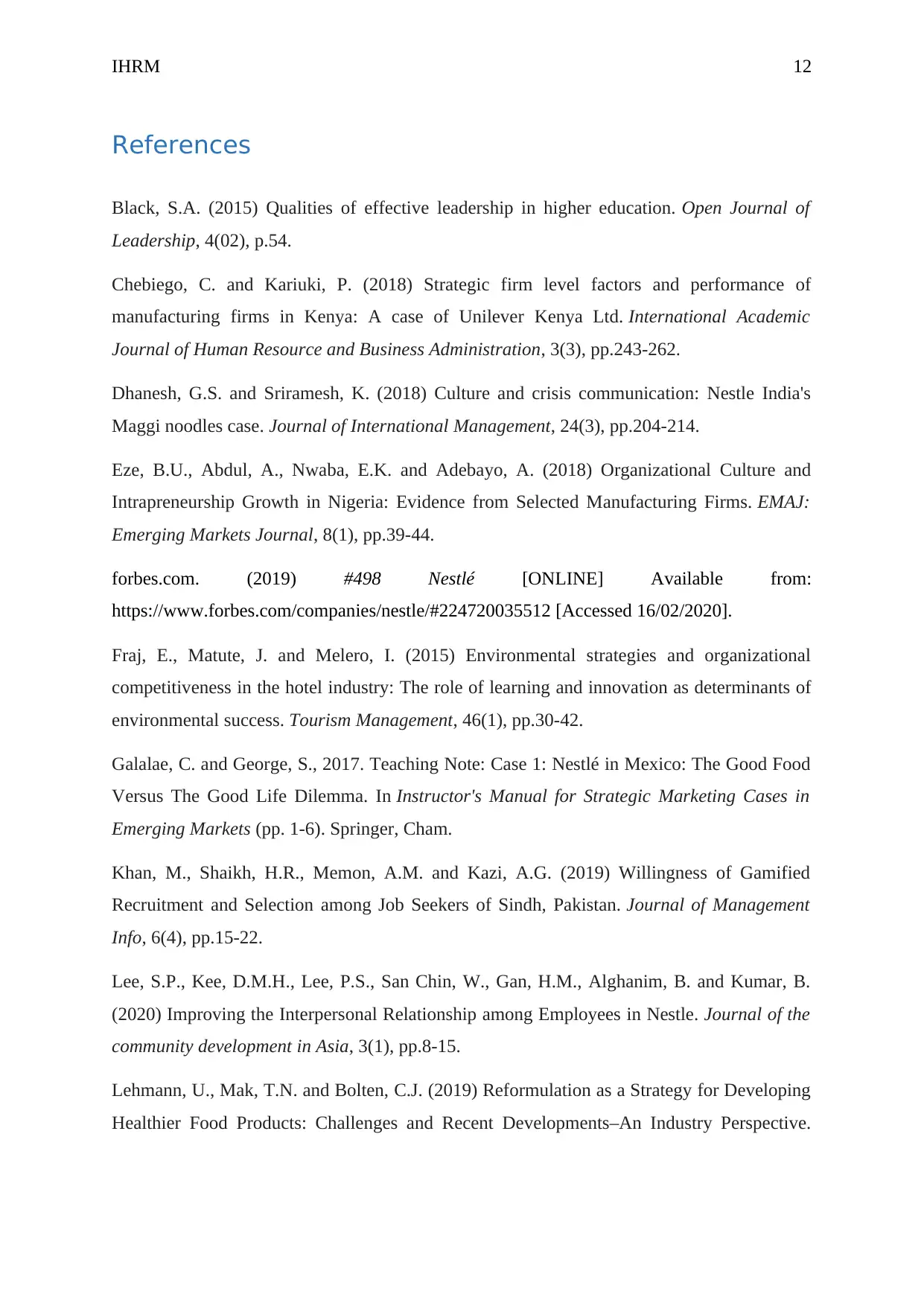
IHRM 12
References
Black, S.A. (2015) Qualities of effective leadership in higher education. Open Journal of
Leadership, 4(02), p.54.
Chebiego, C. and Kariuki, P. (2018) Strategic firm level factors and performance of
manufacturing firms in Kenya: A case of Unilever Kenya Ltd. International Academic
Journal of Human Resource and Business Administration, 3(3), pp.243-262.
Dhanesh, G.S. and Sriramesh, K. (2018) Culture and crisis communication: Nestle India's
Maggi noodles case. Journal of International Management, 24(3), pp.204-214.
Eze, B.U., Abdul, A., Nwaba, E.K. and Adebayo, A. (2018) Organizational Culture and
Intrapreneurship Growth in Nigeria: Evidence from Selected Manufacturing Firms. EMAJ:
Emerging Markets Journal, 8(1), pp.39-44.
forbes.com. (2019) #498 Nestlé [ONLINE] Available from:
https://www.forbes.com/companies/nestle/#224720035512 [Accessed 16/02/2020].
Fraj, E., Matute, J. and Melero, I. (2015) Environmental strategies and organizational
competitiveness in the hotel industry: The role of learning and innovation as determinants of
environmental success. Tourism Management, 46(1), pp.30-42.
Galalae, C. and George, S., 2017. Teaching Note: Case 1: Nestlé in Mexico: The Good Food
Versus The Good Life Dilemma. In Instructor's Manual for Strategic Marketing Cases in
Emerging Markets (pp. 1-6). Springer, Cham.
Khan, M., Shaikh, H.R., Memon, A.M. and Kazi, A.G. (2019) Willingness of Gamified
Recruitment and Selection among Job Seekers of Sindh, Pakistan. Journal of Management
Info, 6(4), pp.15-22.
Lee, S.P., Kee, D.M.H., Lee, P.S., San Chin, W., Gan, H.M., Alghanim, B. and Kumar, B.
(2020) Improving the Interpersonal Relationship among Employees in Nestle. Journal of the
community development in Asia, 3(1), pp.8-15.
Lehmann, U., Mak, T.N. and Bolten, C.J. (2019) Reformulation as a Strategy for Developing
Healthier Food Products: Challenges and Recent Developments–An Industry Perspective.
References
Black, S.A. (2015) Qualities of effective leadership in higher education. Open Journal of
Leadership, 4(02), p.54.
Chebiego, C. and Kariuki, P. (2018) Strategic firm level factors and performance of
manufacturing firms in Kenya: A case of Unilever Kenya Ltd. International Academic
Journal of Human Resource and Business Administration, 3(3), pp.243-262.
Dhanesh, G.S. and Sriramesh, K. (2018) Culture and crisis communication: Nestle India's
Maggi noodles case. Journal of International Management, 24(3), pp.204-214.
Eze, B.U., Abdul, A., Nwaba, E.K. and Adebayo, A. (2018) Organizational Culture and
Intrapreneurship Growth in Nigeria: Evidence from Selected Manufacturing Firms. EMAJ:
Emerging Markets Journal, 8(1), pp.39-44.
forbes.com. (2019) #498 Nestlé [ONLINE] Available from:
https://www.forbes.com/companies/nestle/#224720035512 [Accessed 16/02/2020].
Fraj, E., Matute, J. and Melero, I. (2015) Environmental strategies and organizational
competitiveness in the hotel industry: The role of learning and innovation as determinants of
environmental success. Tourism Management, 46(1), pp.30-42.
Galalae, C. and George, S., 2017. Teaching Note: Case 1: Nestlé in Mexico: The Good Food
Versus The Good Life Dilemma. In Instructor's Manual for Strategic Marketing Cases in
Emerging Markets (pp. 1-6). Springer, Cham.
Khan, M., Shaikh, H.R., Memon, A.M. and Kazi, A.G. (2019) Willingness of Gamified
Recruitment and Selection among Job Seekers of Sindh, Pakistan. Journal of Management
Info, 6(4), pp.15-22.
Lee, S.P., Kee, D.M.H., Lee, P.S., San Chin, W., Gan, H.M., Alghanim, B. and Kumar, B.
(2020) Improving the Interpersonal Relationship among Employees in Nestle. Journal of the
community development in Asia, 3(1), pp.8-15.
Lehmann, U., Mak, T.N. and Bolten, C.J. (2019) Reformulation as a Strategy for Developing
Healthier Food Products: Challenges and Recent Developments–An Industry Perspective.
Paraphrase This Document
Need a fresh take? Get an instant paraphrase of this document with our AI Paraphraser
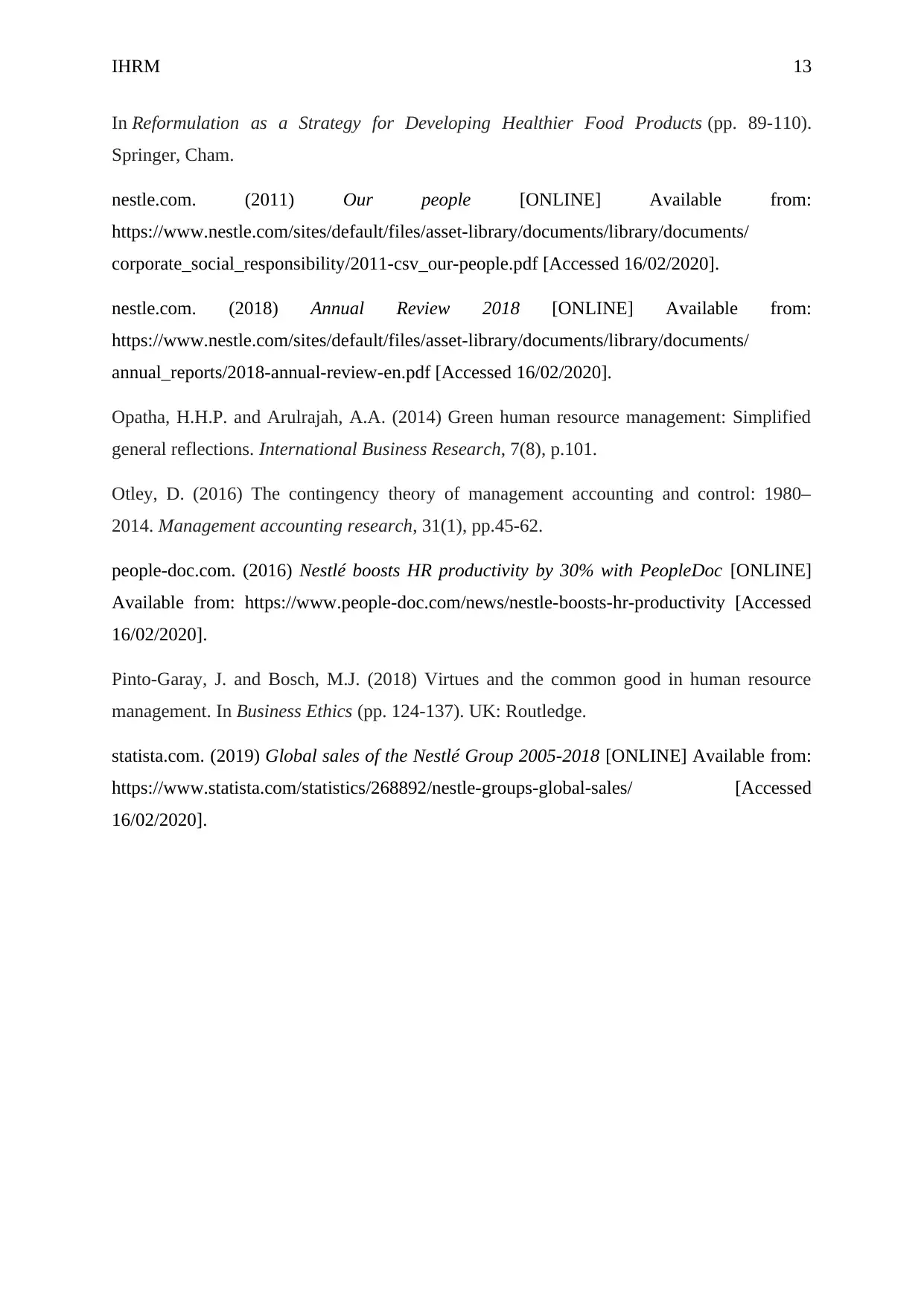
IHRM 13
In Reformulation as a Strategy for Developing Healthier Food Products (pp. 89-110).
Springer, Cham.
nestle.com. (2011) Our people [ONLINE] Available from:
https://www.nestle.com/sites/default/files/asset-library/documents/library/documents/
corporate_social_responsibility/2011-csv_our-people.pdf [Accessed 16/02/2020].
nestle.com. (2018) Annual Review 2018 [ONLINE] Available from:
https://www.nestle.com/sites/default/files/asset-library/documents/library/documents/
annual_reports/2018-annual-review-en.pdf [Accessed 16/02/2020].
Opatha, H.H.P. and Arulrajah, A.A. (2014) Green human resource management: Simplified
general reflections. International Business Research, 7(8), p.101.
Otley, D. (2016) The contingency theory of management accounting and control: 1980–
2014. Management accounting research, 31(1), pp.45-62.
people-doc.com. (2016) Nestlé boosts HR productivity by 30% with PeopleDoc [ONLINE]
Available from: https://www.people-doc.com/news/nestle-boosts-hr-productivity [Accessed
16/02/2020].
Pinto-Garay, J. and Bosch, M.J. (2018) Virtues and the common good in human resource
management. In Business Ethics (pp. 124-137). UK: Routledge.
statista.com. (2019) Global sales of the Nestlé Group 2005-2018 [ONLINE] Available from:
https://www.statista.com/statistics/268892/nestle-groups-global-sales/ [Accessed
16/02/2020].
In Reformulation as a Strategy for Developing Healthier Food Products (pp. 89-110).
Springer, Cham.
nestle.com. (2011) Our people [ONLINE] Available from:
https://www.nestle.com/sites/default/files/asset-library/documents/library/documents/
corporate_social_responsibility/2011-csv_our-people.pdf [Accessed 16/02/2020].
nestle.com. (2018) Annual Review 2018 [ONLINE] Available from:
https://www.nestle.com/sites/default/files/asset-library/documents/library/documents/
annual_reports/2018-annual-review-en.pdf [Accessed 16/02/2020].
Opatha, H.H.P. and Arulrajah, A.A. (2014) Green human resource management: Simplified
general reflections. International Business Research, 7(8), p.101.
Otley, D. (2016) The contingency theory of management accounting and control: 1980–
2014. Management accounting research, 31(1), pp.45-62.
people-doc.com. (2016) Nestlé boosts HR productivity by 30% with PeopleDoc [ONLINE]
Available from: https://www.people-doc.com/news/nestle-boosts-hr-productivity [Accessed
16/02/2020].
Pinto-Garay, J. and Bosch, M.J. (2018) Virtues and the common good in human resource
management. In Business Ethics (pp. 124-137). UK: Routledge.
statista.com. (2019) Global sales of the Nestlé Group 2005-2018 [ONLINE] Available from:
https://www.statista.com/statistics/268892/nestle-groups-global-sales/ [Accessed
16/02/2020].
1 out of 14
Related Documents
Your All-in-One AI-Powered Toolkit for Academic Success.
+13062052269
info@desklib.com
Available 24*7 on WhatsApp / Email
![[object Object]](/_next/static/media/star-bottom.7253800d.svg)
Unlock your academic potential
© 2024 | Zucol Services PVT LTD | All rights reserved.




